cooking class
Four basic ingredients and about an hour (and no special equipment needed)—that’s all it takes to make fresh pasta. Just knead, roll, and hand-cut the noodles to boil now or freeze for later.

Egg noodles
Prepare as directed, except start with 1¾ cups flour in Step 1 and substitute 1 egg + 2 egg yolks for the 2 eggs. Sprinkle ¼ cup flour on surface, then knead, roll, cut, and cook as directed.
Homemade pasta
hands-on time 40 minutes
stand 20 minutes
- 2⅓ cups all-purpose flour
- ½ tsp. salt
- 2 eggs, lightly beaten
- ⅓ cup water
- 1 tsp. olive oil
1. In a large bowl stir together 2 cups of the flour and the salt; make a well in the center. In a bowl combine eggs, water, and oil; add to flour mixture. Stir to combine.
2. Sprinkle a kneading surface with remaining ⅓ cup flour. Knead dough until smooth and elastic (8 to 10 minutes total). Cover dough; let rest 10 minutes. Divide the dough into four equal portions. (Or to freeze the dough, wrap in plastic wrap. Freeze in an airtight container up to 3 months. Thaw completely in the refrigerator; continue with Step 3.)
3. On a lightly floured surface, roll each portion into a 12-inch square about ¹⁄₁₆ inch thick (dough is thin enough when you can start to see through it). Lightly dust with flour. Let stand, uncovered, 20 minutes; cut as desired (tips, opposite). (If using a pasta machine, pass each portion through machine according to manufacturer’s directions until dough is ¹⁄₁₆ inch thick. Let stand 20 minutes; cut as desired.)
4. To serve pasta immediately, cook in a large pot of boiling, salted water 2 to 3 minutes or until tender; drain.
5. To store cut pasta, spread it on a wire cooling rack or hang it from a pasta-drying rack. Let dry 2 hours. Place in an airtight container and chill up to 3 days. Or dry the pasta at least 1 hour; place in a freezer bag or freezer container and freeze up to 8 months (add 1 or 2 minutes to cooking time for frozen pasta).
Makes 5 servings (1 cup each).
each serving 255 cal., 3 g fat (1 g sat. fat), 85 mg chol., 262 mg sodium, 46 g carb., 2 g fiber, 0 g sugars, 8 g pro.

food processor method
Place the steel blade in the food processor. Add all of the flour, salt, and eggs to food processor. Cover; process until mixture forms fine crumbs. With the food processor running, slowly pour the water and oil through feed tube. Continue processing until the dough forms a ball. Transfer dough to a lightly floured surface. Cover; let dough rest 10 minutes. Divide the dough into four equal portions. Continue as directed in Step 3.
traditional semolina pasta
Semolina—a coarse wheat flour—is commonly used in fresh Italian pasta, giving it a more granular texture. Most large supermarkets carry semolina near other flours.
In a bowl combine 1 cup all-purpose flour and ¼ cup semolina flour; create a well in the center. Add 2 eggs. Using a fork, gently beat eggs, mixing in flour with each stroke. Stir as dough thickens. When it can no longer be stirred, knead in remaining flour until firm and elastic. Cover; let rest 20 minutes. On a lightly floured surface roll dough into an 18-inch circle about ¹⁄₁₆ inch thick. Lightly flour surface of the dough. Cut as directed above right. Let stand 1 hour. Cook as directed in Step 4 (opposite).
Makes 4 servings (about 1 cup each).
each serving 187 cal., 3 g fat (1 g sat. fat), 93 mg chol., 36 mg sodium, 32 g carb., 1 g fiber, 0 g sugars, 8 g pro.
Long Pasta
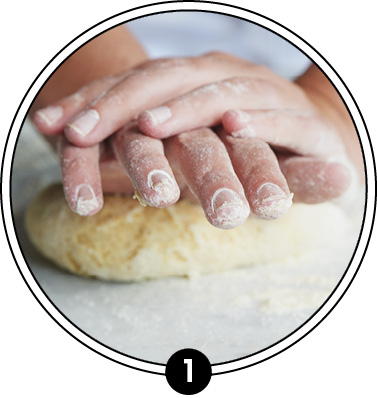
Knead the dough, adding flour as necessary to keep it from sticking, about 10 minutes or until dough is nice and smooth. This creates a gluten structure that binds the dough and gives the noodles their chewy texture.
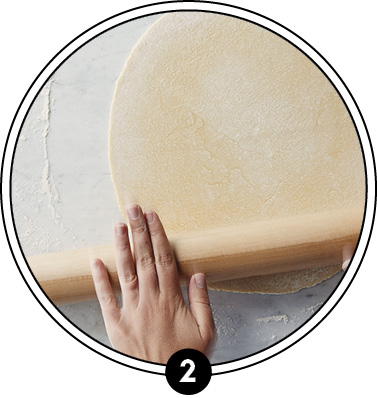
Using a long rolling pin, roll dough away from you, pushing down and stretching the dough as you roll. If the dough snaps back into place, let it rest a bit longer. Rotate and flip it over once or twice, dusting with flour as necessary.

Loosely roll each dough portion into a spiral. Use a sharp knife to cut pasta into desired-size strips. Unroll the ribbons. If desired, cut into shorter lengths. Cook or dry and store as directed in recipe.
meat-filled ravioli
For filling, in an 8-inch skillet cook 6 oz. ground beef or bulk Italian sausage until no longer pink; drain. In a small bowl stir together ⅓ cup ricotta cheese, ⅓ cup shredded mozzarella cheese, 3 Tbsp. grated Parmesan cheese, and ½ tsp. Italian seasoning. Stir in meat mixture.
To shape ravioli, cut rolled dough into 2-inch-wide strips. Leaving a ½-inch margin around the edges, place about 1 tsp. desired filling at 1-inch intervals on one strip of the dough.
Using your finger, moisten the dough with water around the mounds of filling. Lay a second strip of dough over the first. Press pasta around each mound of filling so that the two strips of dough stick together.
With a sharp knife, trim edges and cut pasta between the mounds of filling to separate into uniform-size individual ravioli. Let stand 10 minutes before cooking.
Cook ravioli in a large pot of boiling water 6 to 8 minutes or until tender.
Makes about 48 ravioli.
per 6 ravioli 247 cal., 9 g fat (4 g sat. fat), 71 mg chol., 245 mg sodium, 29 g carb., 1 g fiber, 0 g sugars, 12 g pro.

cooking class
Gnocchi (NYOH-kee), which translates to “lumps” in italian, are small, slightly chewy potato Pasta dumplings. The signature airy but toothsome texture relies on the russet potato and a light hand with the flour and kneading.
Potato Gnocchi with Browned Butter Sauce
hands-on time 1 hour 5 minutes
bake 45 minutes at 425°F
- 1½ lb. russet potatoes
- 2 egg yolks
- ½ tsp. salt
- ⅛ tsp. black or white pepper
- ¾ to 1 cup all-purpose flour
- ¼ cup butter
- 2 Tbsp. chopped fresh parsley
- ½ cup finely shredded Parmesan cheese (2 oz.)
- Lemon wedges
1. Preheat oven to 425°F. Prick potatoes with a fork. Bake 45 to 60 minutes or until tender and fork inserts easily. Holding each potato with an oven mitt or towel, peel quickly.
2. Press the peeled hot potatoes through a ricer or food mill into a large bowl.
3. In a bowl whisk together egg yolks, salt, and pepper. Make a well in the center of the potatoes; add egg mixture. Stir to combine. Add ¾ cup of the flour, stirring just until combined (use your hands if necessary). On a lightly floured surface, knead in just enough of the remaining flour (may not need any) to make a smooth, fairly soft dough that is still slightly sticky. Do not overknead or add too much flour.
4. Divide dough into four portions. Roll each portion into a long, thin rope ¾ to 1 inch thick. Cut ropes into ½-inch pieces. Roll each piece into a little ball, adding more flour to the work surface as needed. Roll balls over a lightly floured gnocchi paddle or on a fork to create patterned ridges (tip, opposite, top right). Place gnocchi on a baking sheet lightly dusted with flour. Set aside until ready to cook. (Or place in freezer and freeze until firm. Transfer frozen gnocchi to a freezer bag; freeze up to 3 months.)
5. Place butter in a 10-inch skillet. Heat over medium-low heat 15 to 17 minutes or until butter turns light brown (watch so it doesn’t burn).
6. In a large pot or Dutch oven bring a large amount of lightly salted water to boiling; reduce heat to a slow simmer. Add half of the gnocchi, stirring to prevent them from sticking together. Cook 2 to 3 minutes for frozen gnocchi or until gnocchi rise to the top. Using a slotted spoon, transfer gnocchi to a tray or shallow baking pan. Repeat with the remaining gnocchi.
7. Return browned butter to medium heat. Stir all of the gnocchi and parsley into browned butter and toss gently until well coated. Cook and stir gently 1 to 2 minutes or until heated through. Transfer to a serving dish. Top with Parmesan cheese. Serve with lemon wedges.
Makes 6 servings (15 gnocchi each).
each serving 249 cal., 12 g fat (7 g sat. fat), 89 mg chol., 431 mg sodium, 28 g carb., 2 g fiber, 1 g sugars, 8 g pro.
NO RICER OR FOOD MILL? Shred the cooked potatoes using a box grater (tip, opposite, top right).

russet does best
Starchy, mealy-textured russet potatoes give gnocchi that light and tender bite. Waxier potatoes, such as Yukon golds, tend to give gnocchi a gummier texture.
The lightest touch
To avoid overdeveloping the gluten in the flour—which results in dense, heavy gnocchi—knead the dough just until smooth.



Quickly peel the hot potatoes, then press the pulp through a ricer. This is the easiest method to achieve a smooth texture.

If you don’t have a potato ricer, use a box grater to finely shred the potatoes. (To protect your hand, use a kitchen towel to hold the hot potato as you shred.)
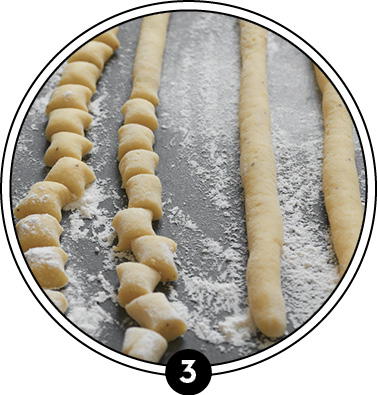
On a lightly floured surface, use your hands to gently roll each dough portion into a ¾- to 1-inch-thick rope. Use a table knife to cut each rope into 20 to 22 pieces, about ½ inch in size.

Roll each piece into a ball. Place one ball on a floured fork (or gnocchi paddle) and press with your fingers, rolling dough to make ridges. You will end up with ridges on one side and an indentation on the other side.
browning butter
Cook the butter until it turns light brown and has a nutty aroma. Pay attention—the butter can quickly go from golden to burned.


egg noodles 1. Fine 2. Medium 3. Wide/Extra Wide ■ tube pasta 1. Manicotti 2. Long ziti 3. Bucatini 4. Campanelle 5. Ziti 6. Ditalini 7. Mostaccioli 8. Elbow 9. Cavatappi 10. Rigatoni 11. Penne ■ filled pasta 1. Tortellini 2. Ravioli ■ long pasta 1. Nested angel hair 2. Lasagna 3. Mafalda 4. Fettuccine 5. Linguine 6. Spaghetti 7. Vermicelli 8. Cappellini ■ shape pasta 1. Wagon wheel 2. Farfalle 3. Farfallini 4. Gnocchi shells 5. Rotini 6. Tiny shells 7. Medium shells 8. Orecchiette 9. Radiatore 10. Gemelli 11. Cavatelli 12. Jumbo shells ■ tiny pasta 1. Orzo 2. Couscous 3. Israeli couscous 4. Acini de pepe
pairing pasta
Pasta comes in all lengths, shapes, and thicknesses. It’s hard to go wrong when matching pasta with sauces and soups, but here are some recommendations to start with.
soup pastas Fine egg noodles, ditalini, orzo, acini de pepe, small tortellini, small ravioli
pasta for chunky, thick sauces Wide egg noodles, farfalle, rotini, rigatoni, campanelle, spaghetti, fettuccine
pasta for light sauces Angel hair, linguine, tortellini, ravioli, ziti
pasta for stuffing Manicotti, jumbo shells
pasta for salads Farfalle, wagon wheel, radiatore, ziti, elbow, gemelli, tortellini
special pastas
The pasta aisle is full of alternatives to traditional pastas. They offer different textures and nutritional benefits.
gluten-free This type of pasta is made using a combination of rice, corn, potatoes, quinoa, and other gluten-free starches. Because brands of this product vary greatly, you might need to try a few before finding one you like.
multigrain Made from a mixture of grains, seeds, and sometimes legumes, multigrain pasta has a high fiber and protein content and is often enriched with omega-3 fatty acids and other essential nutrients.
vegetable-base Made with pureed vegetables, such as spinach, tomatoes, beets, and zucchini, these types of pasta often boast a full serving of vegetables in each serving.
white fiber This product contains similar amounts of fiber and protein as whole wheat pasta, but it has the texture and appearance of regular pasta.
whole wheat This pasta offers a rich, nutty flavor and higher protein and fiber content than traditional white flour-based pasta.

Creamy Baked Ziti
hands-on time 30 minutes
bake 30 minutes at 425°F
- 4 cups dried ziti or penne pasta (12 oz.)
- 1 14.5-oz. can fire-roasted diced tomatoes, undrained
- 1 cup chopped onion
- 12 cloves garlic, minced (2 Tbsp.)
- 2 Tbsp. olive oil
- ½ cup dry white wine
- 2 cups heavy cream
- 1 cup finely shredded Parmesan cheese
- ¾ cup crumbled Gorgonzola or other blue cheese (3 oz.)
- ½ cup shredded Fontina cheese (2 oz.)
- ½ tsp. salt
- ¼ tsp. black pepper
- Snipped fresh Italian parsley (optional)
1. Preheat oven to 425°F. In a 6-qt. pot cook pasta according to package directions; drain. Place in an ungreased 3-qt. rectangular baking dish; stir in undrained tomatoes.
2. Meanwhile, in a 3-qt. saucepan cook onion and garlic in hot oil over medium heat just until tender. Carefully stir in wine and cook about 3 minutes or until liquid reduces by half. Add cream; heat to boiling. Boil gently, uncovered, about 5 minutes or until mixture thickens slightly, stirring frequently. Remove from heat. Stir in cheeses, salt, and pepper.
3. Pour cheese sauce over pasta. Bake, covered, 30 to 35 minutes or until sauce is bubbly. Stir pasta to coat. If desired, top with parsley.
Makes 6 servings.
each serving 717 cal., 46 g fat (26 g sat. fat), 141 mg chol., 883 mg sodium, 54 g carb., 3 g fiber, 5 g sugars, 21 g pro.

The perfect serving
Typically, a serving is 1½ to 2 oz. dried pasta—any shape or size. Cook pasta in a large pot of salted, boiling water according to package directions.
WHOLE TOMATOES can be cut with kitchen scissors while they’re still in the can to contain any mess.
Marinara Sauce
hands-on time 15 minutes
cook 30 minutes
- 1 Tbsp. olive oil
- 1 cup finely chopped onion
- 2 Tbsp. minced garlic
- 2 28-oz. cans San Marzano tomatoes, undrained and snipped
- 2 28-oz. cans crushed tomatoes
- 2 tsp. sugar (optional)
- 1 tsp. salt
- ½ tsp. black pepper
1. In an 8-qt. pot heat oil over medium heat. Add onion and garlic; cook 3 to 5 minutes or until onion is tender, stirring occasionally.
2. Stir in remaining ingredients. Bring to boiling; reduce heat. Simmer, uncovered, 30 minutes or until slightly thickened, stirring occasionally.
Makes 24 servings (½ cup each).
To Store Transfer sauce to an airtight container(s). Cover; chill up to 3 days or freeze up to 3 months.
each serving 44 cal., 1 g fat (0 g sat. fat), 0 mg chol., 272 mg sodium, 9 g carb., 2 g fiber, 6 g sugars, 2 g pro.

San Marzano tomatoes
are imported from Italy, where they are grown in the nutrient-rich volcanic soils near Mt. Vesuvius—only tomatoes from there can legally go by the name San Marzano. Their deep red color, dense flesh, and sweet flavor make them ideal for sauces. Look for canned San Marzano tomatoes at large supermarkets and specialty food stores. If you can’t find them, any canned whole peeled tomatoes work.
make it a meal
What’s on the side? Make a quick grilled romaine salad. Halve 1 medium heart of romaine lettuce; brush cut sides with olive oil. Grill, covered, 1 to 3 minutes or until grill marks develop on the romaine and the romaine is slightly wilted. Drizzle with Fresh Herb Vinaigrette (see recipe) or purchased vinaigrette.

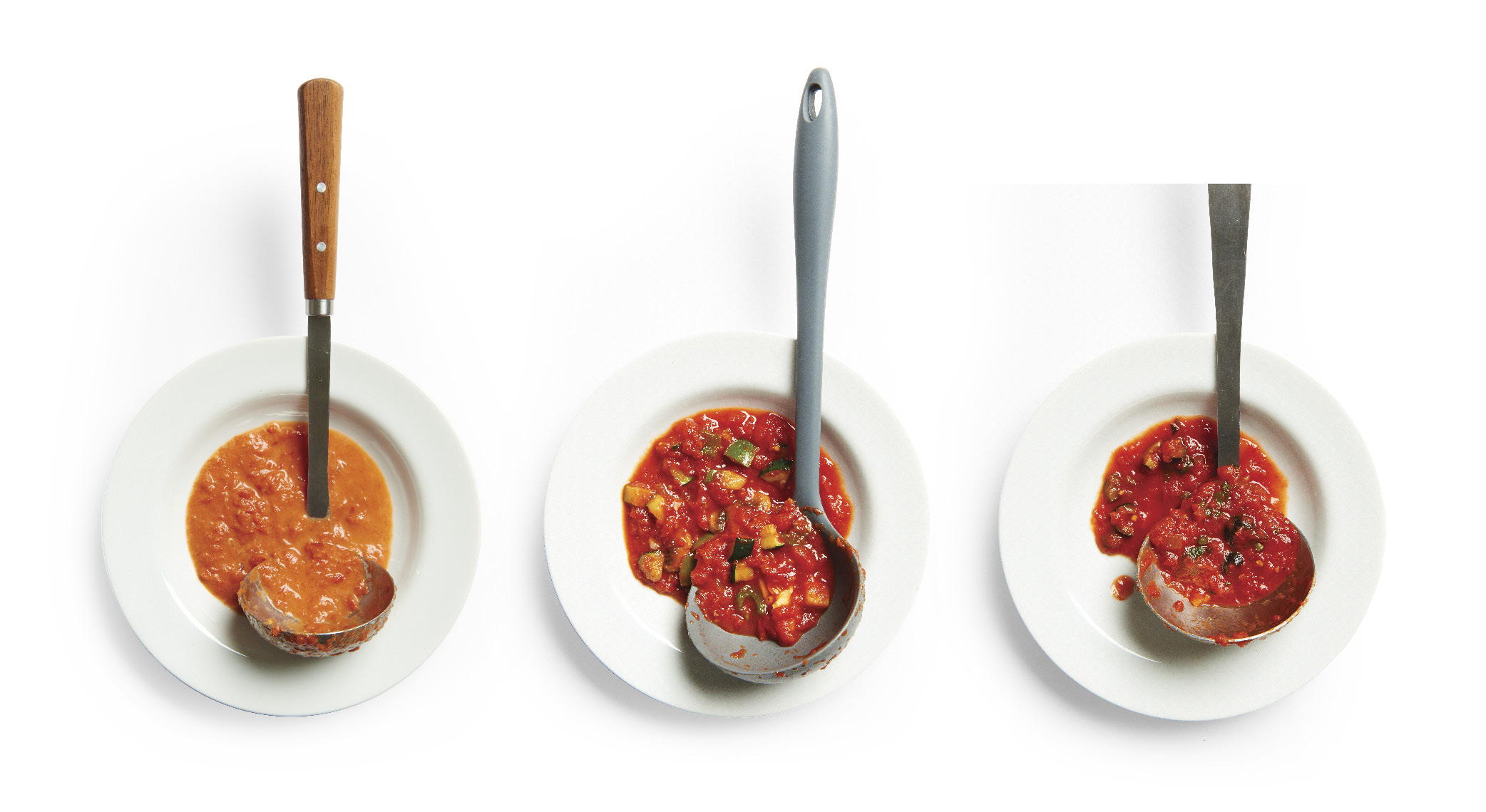
Creamy Vodka sauce Prepare as directed, except stir in ¼ cup vodka with the tomatoes in Step 2. Simmer as directed. Before serving or storing, stir in ¾ cup heavy cream.
Garden Vegetable sauce Prepare as directed, except increase olive oil to 2 Tbsp. Add 1 cup chopped green sweet pepper, 1 cup quartered canned artichoke hearts, 1 cup sliced fresh mushrooms, and 1 cup chopped zucchini or eggplant with the onion in Step 1. Continue as directed.
Puttanesca sauce Prepare as directed, except mash 3 or 4 anchovy fillets into onion mixture in Step 1; cook 30 seconds more. Stir ½ cup sliced pitted ripe olives and 2 Tbsp. drained capers into sauce. If desired, stir in ½ cup chopped fresh parsley and ¼ tsp. crushed red pepper.
Marinara Sauce with meatballs Prepare as directed through Step 2. For meatballs, preheat oven to 375°F. In a large bowl combine 2 eggs; ½ cup each fine dry bread crumbs and finely chopped onion; ¼ cup each milk and chopped fresh parsley; 1 clove garlic, minced; ½ tsp. each salt and black pepper; and ¼ tsp. crushed red pepper. Add 1 lb. each bulk pork sausage and ground beef; mix well. Shape mixture into 16 meatballs; place in a shallow baking pan. Bake about 25 minutes or until meatballs are cooked through (160°F), turning occasionally. Use tongs to transfer meatballs to sauce.
Makes 16 meatballs.
per meatball 168 cal., 12 g fat (4 g sat. fat), 62 mg chol., 287 mg sodium, 4 g carb., 0 g fiber, 1 g sugars, 11 g pro.

shaping meatballs
For 16 equal-size meatballs, shape the meat mixture into an 8-inch square on a cutting board. Cut the square into sixteen 2-inch squares. Roll each square into a ball.

freezing meatballs
Make a double batch of meatballs and freeze some for later meals.
to freeze, place cooked meatballs in a single layer on a baking sheet. Freeze them overnight and repack in resealable freezer bags. Label with the date and return to the freezer. Use within 2 months.
to use, thaw meatballs in the refrigerator or microwave. Serve meatballs whole in soups and sandwiches or sliced on top of pizza. Or add them to your favorite sauce, heat through, and serve over pasta.
what is bolognese (boh-luhn-yayz)? This rich Tomato-meat sauce is a specialty of the bologna region of italy. It stands out from other sauces with a heavy-handed pour of both wine and whole milk.
Bolognese
hands-on time 50 minutes
cook 3 hours 10 minutes
- 2 Tbsp. butter
- 1 Tbsp. olive oil
- 4 oz. pancetta, chopped
- 1 cup chopped onion
- 1 cup chopped carrots
- 1 cup chopped fennel stems (not the bulb)*
- 2 lb. ground beef
- 1 lb. ground pork
- ½ tsp. kosher salt
- ½ tsp. black pepper
- 2 cups dry white wine
- 1½ cups whole milk
- ⅛ tsp. ground nutmeg
- 1 28-oz. can whole tomatoes, undrained and cut up
- 1 Parmesan cheese rind
- (tip, opposite)
- Hot cooked pasta
1. In a 4-qt. Dutch oven heat butter and oil over medium-high heat. Add pancetta; cook and stir about 8 minutes or until starting to brown, stirring occasionally. Reduce heat to medium. Add onion. Cook and stir about 5 minutes or until translucent. Add carrots and fennel. Cook 2 minutes more.
2. Add the beef and pork to Dutch oven. Season with salt and pepper. Using a wooden spoon, break up meat (you want to retain some larger pieces for texture). Cook until browned. Add the wine. Scrape up the browned bits from the bottom of the Dutch oven. Simmer, uncovered, until the wine has evaporated, about 40 minutes.
3. Add the milk and nutmeg. Simmer, uncovered, about 20 minutes or until the milk has evaporated, stirring frequently. Once the milk has evaporated, add the tomatoes; stir to combine. When the tomatoes just start to bubble, reduce heat to low and add the Parmesan rind. Cook, uncovered, 2½ to 3 hours, stirring occasionally. As the sauce cooks, liquid will evaporate and the sauce will start to look dry. Add ½ cup water at a time (2 to 3 cups water total) and continue to simmer as liquid evaporates. Serve over hot cooked pasta.
Makes 12 servings (¾ cup sauce each).
*Note Save the fennel bulb for another use.
To Store Transfer mixture to an airtight storage container(s). Cover and chill up to 3 days or freeze up to 3 months.
each serving 408 cal., 28 g fat (11 g sat. fat), 94 mg chol., 444 mg sodium, 8 g carb., 2 g fiber, 5 g sugars, 23 g pro.
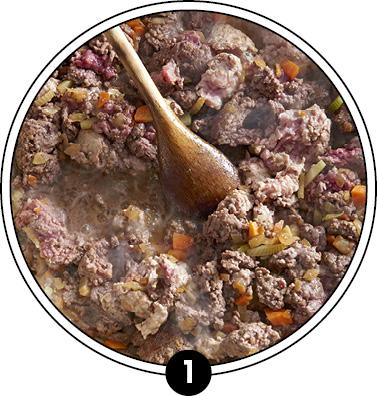
Browning the meat is the first step to creating layers of flavor in this sauce. Take your time. Deep caramelizing on the veggies and meat adds to the richness.

When you add the wine, the liquid helps release those flavorful browned bits at the bottom of the Dutch oven. A wooden spoon is the best tool for scraping them up.
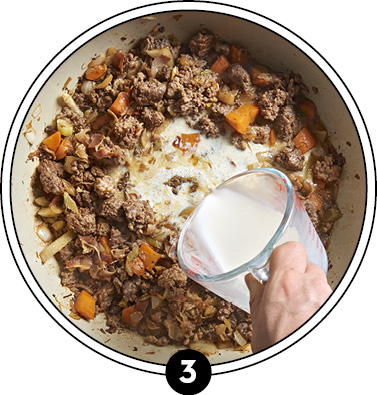
It might seem like an odd stage to add milk, but cooking away the liquid before adding the tomatoes makes the meat even richer and sweet without making the sauce overly creamy.

Keep the heat as low as possible. You want the slightest bubbling for ultratender meat. Add a little water to keep the sauce from sticking to the bottom of the pot.
go for al dente
To bring out pasta’s full, nutty flavor, cook it just until it has the firm, slightly chewy texture known as al dente (Italian for “to the tooth”). Test near the end of cooking time by giving it a taste. When done, drain the cooked pasta in a colander; shake well to remove. Do not rinse unless specified.

THE RIND is the outer layer of Parmesan cheese wedges (available at cheese counters). After grating the cheese from the wedge, simmer the rind in your sauce for a deliciously rich flavor.
Spaghetti alla Carbonara
start to finish 40 minutes
- 12 oz. dried spaghetti
- 6 oz. pancetta or bacon, finely chopped
- ½ cup chopped onion
- 2 cloves garlic, minced
- ¼ cup dry white wine
- 2 pasteurized egg yolks or ¼ cup refrigerated or frozen egg product, thawed
- ¼ cup heavy cream
- 1 cup finely shredded Parmigiano-Reggiano or Parmesan cheese (4 oz.)
- ½ tsp. black pepper
1. In a 6-qt. pot cook pasta according to package directions; drain, reserving ½ cup pasta water. Return pasta to pot; keep warm.
2. Meanwhile, in a 12-inch skillet cook and stir pancetta over medium heat until crisp. Using a slotted spoon, transfer pancetta to a paper towel-lined plate. Drain all but 2 Tbsp. drippings from the skillet.
3. Add onion and garlic to hot drippings in skillet; cook and stir over medium heat about 5 minutes or until onion is tender. Remove skillet from heat; carefully add wine. Return skillet to heat. Bring wine to boiling; reduce heat. Simmer, uncovered, about 3 minutes or until most of the wine evaporates.
4. In a small bowl combine egg yolks or product and cream. Stir in cheese and pepper. Add spaghetti to onion mixture in skillet; toss gently over medium heat 1 to 2 minutes to coat. Remove from heat; add egg mixture, reserved pancetta, and ¼ cup of the pasta water. Toss well to coat. Serve immediately. Add additional pasta water, if needed, to maintain creamy consistency.
Makes 6 servings (1 cup each).
each serving 460 cal., 22 g fat (10 g sat. fat), 41 mg chol., 569 mg sodium, 45 g carb., 2 g fiber, 3 g sugars, 18 g pro.
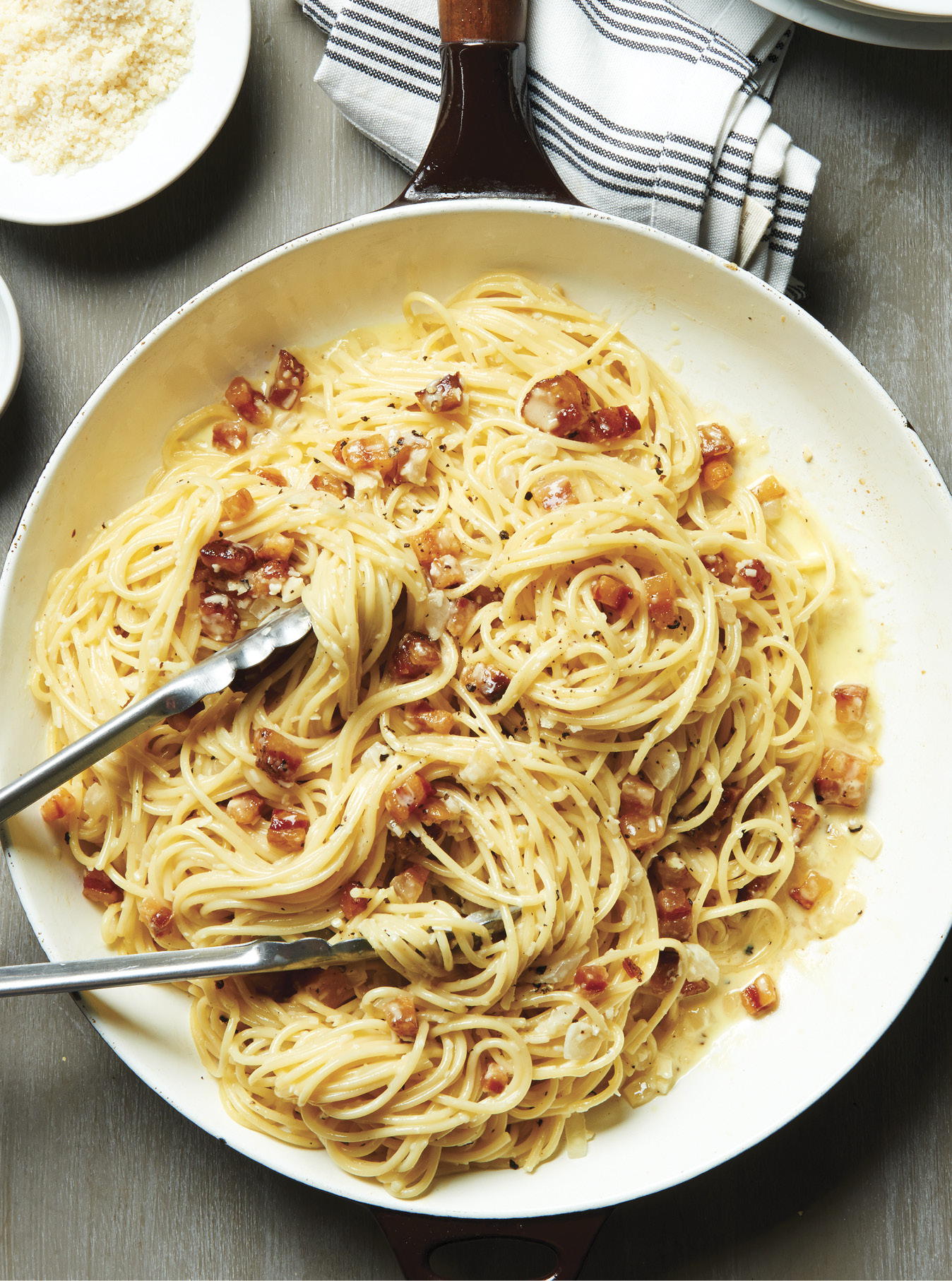
WHOLE PASTEURIZED EGGS—which have been heated just enough to kill bacteria like salmonella—can often be found in the egg case in large supermarkets. You can also use refrigerated egg product from cartons, which is also pasteurized and is easy to find.
classic carbonara
Authentic Italian carbonara sauce is a combination of raw egg, pasta cooking water, and cheese—but getting it to the right consistency is a little tricky. Instead, our weeknight version uses cream for similar richness and body, and wine for luscious flavor.
Fettuccine Alfredo
start to finish 35 minutes
- 8 oz. dried fettuccine
- 2 cloves garlic, minced
- 2 Tbsp. butter
- 1 cup heavy cream
- ½ tsp. salt
- ⅛ tsp. black pepper
- ½ cup grated Parmesan cheese (2 oz.)
1. Cook pasta according to package directions; drain.
2. In a 3-qt. saucepan cook garlic in hot butter over medium-high heat 1 minute. Add cream, salt, and pepper. Bring to boiling; reduce heat. Boil gently, uncovered, 3 minutes or until beginning to thicken. Remove from heat; stir in Parmesan cheese. Add pasta; toss to coat. If desired, top with additional Parmesan cheese.
Makes 4 servings (1¼ cups each).
each serving 514 cal., 32 g fat (19 g sat. fat), 107 mg chol., 511 mg sodium, 45 g carb., 2 g fiber, 2 g sugars, 13 g pro.

fettuccine alfredo
PREGROUND PEPPER works in a pinch, but using a pepper grinder to grind your own peppercorns makes a big difference in flavor.
Tortellini Emilia
hands-on time 30 minutes
bake 20 minutes at 400°F
stand 10 minutes
- 2 8-oz. pkg. dried cheese-filled tortellini
- 3 Tbsp. finely chopped red onion
- 2 Tbsp. finely chopped shallots
- 1 Tbsp. butter
- 2 cups half-and-half
- ½ cup milk
- 2 egg yolks
- ¼ cup grated Parmesan cheese (1 oz.)
- 1 Tbsp. chopped fresh sage or 1 tsp. dried sage, crushed
- ¼ tsp. black pepper
- ½ cup shredded Gruyère or Swiss cheese (2 oz.)
- ½ cup walnut pieces
- 2 oz. prosciutto or cooked ham, finely chopped
1. Preheat oven to 400°F. Cook tortellini according to package directions; drain.
2. For sauce, in a 2-qt. saucepan cook onion and shallots in hot butter over medium heat until tender. Stir in half-and-half and milk. Bring just to boiling; remove from heat. In a bowl lightly beat egg yolks. Slowly add about 1 cup of the hot milk mixture to the beaten yolks, beating until combined. Return all of the egg yolk mixture to saucepan. Cook and stir over medium-low heat about 10 minutes or until slightly thickened and just bubbly. Stir in Parmesan, sage, and pepper.
3. Transfer half of the cooked tortellini to a 2-qt. rectangular or oval baking dish. Sprinkle with the Gruyère cheese. Pour half of the sauce over tortellini. Top with the remaining cooked tortellini, the walnuts, the prosciutto, and the remaining sauce.
4. Bake, uncovered, 20 minutes or until top is lightly browned and bubbly. Let stand 10 minutes. If desired, top with fresh sage.
Makes 8 servings (1 cup each).
each serving 457 cal., 27 g fat (11 g sat. fat), 127 mg chol., 790 mg sodium, 38 g carb., 4 g fiber, 4 g sugars, 18 g pro.

tortellini emilia

grate Pasta cheeses
Your pasta deserves special treatment. Hand-grate blocks of these classic Italian cheeses over pasta and into sauces.
Parmigiano-Reggiano
A granular texture and bold, snappy flavor are hallmarks of this time-honored cheese. Also try it thinly shaved in salads.
Pecorino romano
This gratable sheep’s milk cheese brings a sharp, peppery flavor to dishes.
Aged Asiago
Choose this one for its nutty, pleasantly salty flavor.
Grana Padano
This cheese has a fine texture and sweet, mild, fragrant flavor.
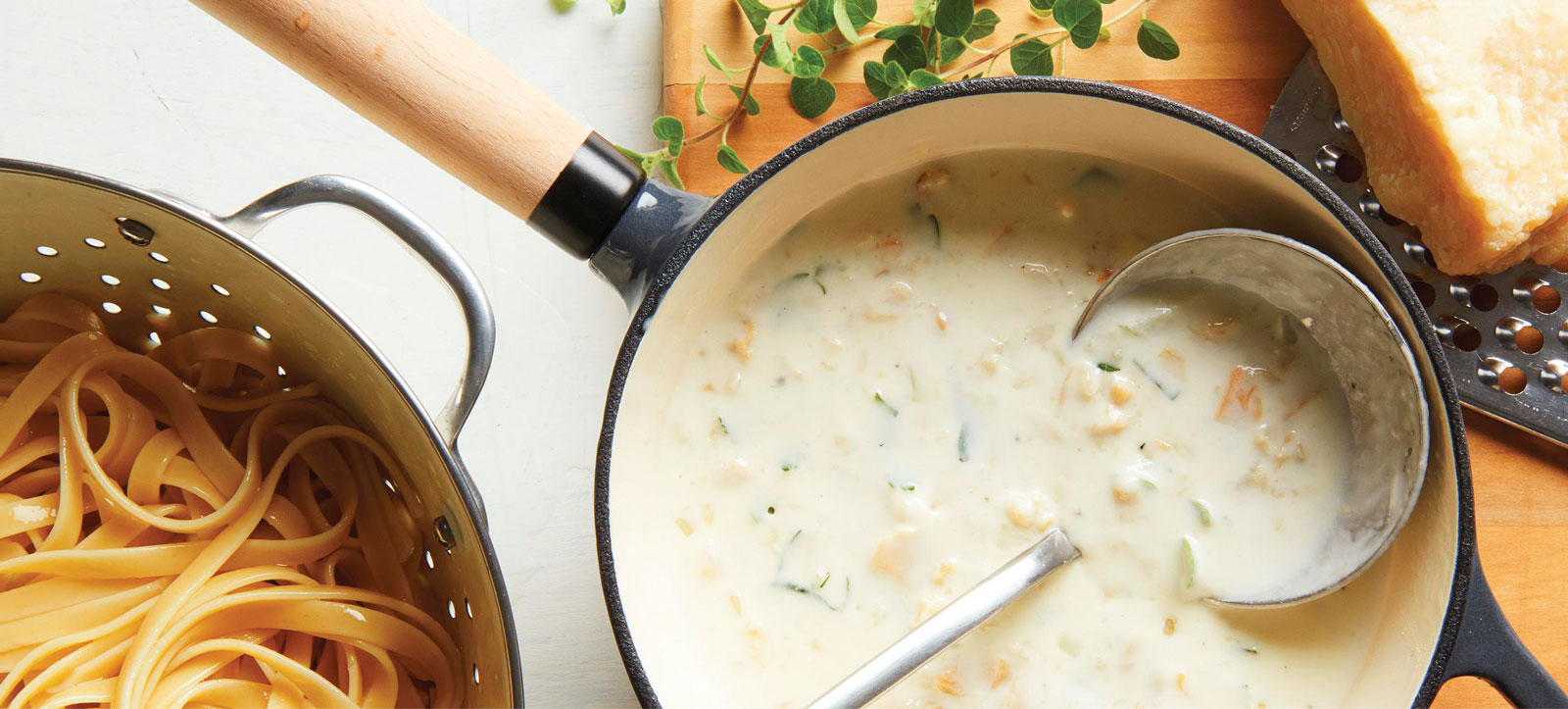
The rinsing question
Rinsing removes a light coating of starch that helps the sauce and seasonings cling. So we recommend not rinsing pasta unless it will be baked or served cool in a salad.
Pasta with White Clam Sauce
start to finish 30 minutes
- 10 oz. dried linguine or fettuccine
- 2 6.5-oz. cans chopped or minced clams
- 2 cups half-and-half or whole milk
- ½ cup chopped onion
- 2 cloves garlic, minced
- 2 Tbsp. butter
- ¼ cup all-purpose flour
- 2 tsp. chopped fresh oregano or ½ tsp. dried oregano, crushed
- ¼ tsp. salt
- ⅛ tsp. black pepper
- ¼ cup chopped fresh parsley
- ¼ cup dry white wine or chicken broth
- ¼ cup finely shredded or grated Parmesan cheese (1 oz.)
1. In a 4-qt. saucepan cook pasta according to package directions; drain and keep warm. Meanwhile, drain canned clams, reserving the juice from one of the cans (you should have about ½ cup). Add enough half-and-half to reserved clam juice to equal 2½ cups liquid.
2. In a 2-qt. saucepan cook onion and garlic in hot butter over medium heat until tender but not brown. Stir in flour, dried oregano (if using), salt, and pepper. Add clam juice mixture all at once. Cook and stir until thickened and bubbly. Cook and stir 1 minute more. Stir in drained clams, fresh oregano (if using), parsley, and wine. Heat through. Serve over hot pasta. Sprinkle with Parmesan cheese.
Makes 4 servings (1½ cups each).
each serving 680 cal., 24 g fat (14 g sat. fat), 125 mg chol., 430 mg sodium, 72 g carb., 3 g fiber, 3 g sugars, 40 g pro.
Shrimp Scampi
start to finish 30 minutes
- 12 oz. fresh or frozen peeled and deveined medium shrimp
- 1 oz. prosciutto, cut into strips
- 1 Tbsp. butter
- 1 Tbsp. olive oil
- 1 Tbsp. minced garlic
- ¼ cup finely chopped shallots
- 1½ cups dry white wine
- 2 Tbsp. lemon juice
- ¼ tsp. salt
- 1 roma tomato, seeded and finely chopped
- 1 Tbsp. finely chopped Italian parsley
- 1 tsp. chopped fresh thyme
- 8 oz. dried angel hair pasta
- Lemon wedges (optional)
1. Thaw shrimp if frozen; set aside. In a 10-inch skillet cook prosciutto over medium heat until crisp. Drain on paper towels.
2. To the same skillet add butter and olive oil. Heat over medium heat. Add garlic; cook and stir 30 seconds. Add shallots; cook and stir about 1 minute or until tender. Add shrimp, wine, lemon juice, and salt; bring to boiling. Reduce heat and simmer, uncovered, 2 to 3 minutes or until shrimp turn opaque, stirring occasionally. Remove shrimp with a slotted spoon; cover and keep warm.
3. Continue to gently boil liquid in skillet, uncovered, about 10 minutes or until thickened and reduced to about 1 cup. Stir in tomato, parsley, and thyme. Cook 1 minute. Return shrimp to skillet; toss gently to coat.
4. Meanwhile, cook pasta according to package directions; drain. Top pasta with shrimp mixture; sprinkle with crisp prosciutto. If desired, serve with lemon wedges.
Makes 4 servings (1½ cups each).
each serving 434 cal., 9 g fat (3 g sat. fat), 147 mg chol., 420 mg sodium, 48 g carb., 3 g fiber, 4 g sugars, 27 g pro.

keeping pasta warm
Pasta has its best flavor and texture immediately after cooking. But if it needs to sit for a bit while you prep the rest of the meal, here’s what to do.
1
return to the pan
Return the drained cooked pasta to the warm cooking pan. Stir in a little olive oil to help prevent the noodles from sticking together. Cover and let the pasta stand no more than 15 minutes.
2
heat & serve
Fill a serving bowl with hot water and let it stand for a few minutes. Empty and dry the bowl. Add the hot pasta and cover; serve the pasta within 5 minutes.
make it a meal
We love serving vibrant scampi with bread to soak up any extra sauce. To make garlicky baguette toasts, rub lightly toasted baguette slices with a halved garlic clove while still warm. Add some extra color to your plate with steamed peas or wilted spinach topped with crumbled crisp-cooked bacon.


make it ahead
Lasagna is a classic prep-ahead dish. Prepare it through Step 3, then cover with plastic wrap. Refrigerate up to 24 hours. Uncover and bake in a 375°F oven 45 to 50 minutes or until hot in the center (160°F).
GROUND TURKEY OR BULK TURKEY ITALIAN SAUSAGE can be substituted for the ground beef and Italian sausage in the Meat Sauce.
Classic Lasagna
hands-on time 45 minutes
bake 35 minutes at 375°F
stand 15 minutes
- 1 recipe Meat Sauce
- 12 dried lasagna noodles
- 1 egg, lightly beaten
- 1 15-oz. container whole milk ricotta cheese or 2 cups cottage cheese, drained
- ¼ cup grated Parmesan cheese
- 3 cups shredded mozzarella cheese (12 oz.)
- Grated Parmesan cheese (optional)
- Snipped fresh basil (optional)
1. Prepare Meat Sauce. Preheat oven to 375°F. Cook lasagna noodles according to package directions; drain. Rinse with cold water; drain again.
2. For filling, in a medium bowl combine egg, ricotta cheese, and the ¼ cup Parmesan cheese.
3. Spread ¼ cup of the sauce into an ungreased 3-qt. rectangular baking dish. Arrange three of the cooked noodles lengthwise over sauce. Spoon one-fourth of the filling over noodles. Top with one-fourth of the remaining sauce and one-fourth of the mozzarella cheese. Repeat layers three more times, starting with noodles and ending with mozzarella cheese (cover top layer of noodles evenly with sauce). If desired, top with additional Parmesan cheese.
4. Bake, uncovered, 35 to 40 minutes or until hot in the center (160°F). Let stand 15 minutes before serving. If desired, garnish with basil.
Makes 12 servings.
each serving 432 cal., 20 g fat (10 g sat. fat), 81 mg chol., 695 mg sodium, 37 g carb., 3 g fiber, 6 g sugars, 24 g pro.
meat sauce
In a 12-inch skillet or saucepan cook 8 oz. ground beef; 8 oz. bulk Italian sausage or ground beef; 1 cup chopped onion; and 3 cloves garlic, minced, over medium-high heat until meat is browned, using a wooden spoon to break up meat as it cooks. Drain fat. Stir in ¼ to ⅓ cup dry red wine; bring to boiling. Stir in one 28-oz. can crushed tomatoes; two 8-oz. cans tomato sauce; 1 Tbsp. dried Italian seasoning, crushed; 1 tsp. fennel seeds, crushed; and ¼ tsp. black pepper. Bring to boiling; reduce heat. Cover and simmer 15 minutes, stirring occasionally.

Lasagna with Béchamel For Béchamel Sauce, prepare Basic White Sauce (p.109) as directed, except add 3 cloves garlic, minced, to the melted butter; cook and stir 1 minute before adding the flour, salt, and pepper. Stir ¼ cup grated Parmesan cheese into finished sauce. Prepare Meat Sauce as directed, except substitute one 15-oz. can crushed tomatoes for the 28-oz. can crushed tomatoes, omit one of the 8-oz. cans tomato sauce, and omit the red wine. Add one-fourth of the Béchamel sauce to each layer over the lasagna filling. Bake as directed.
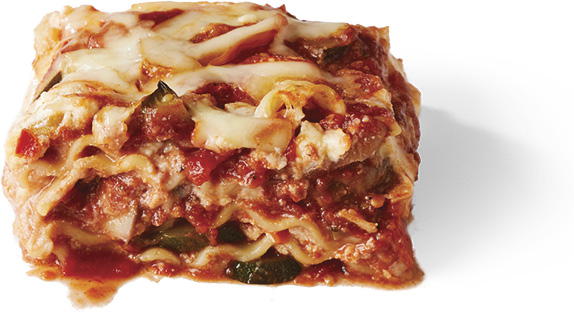
Vegetable Lasagna Prepare as directed in Steps 1 and 2, except omit beef and sausage in Meat Sauce. Cook 1 lb. fresh cremini mushrooms, quartered, and 1 yellow or red sweet pepper, cut into strips, with the onion and garlic in 2 Tbsp. olive oil over medium-high heat 5 minutes. Stir in 1½ cups coarsely chopped zucchini; cook 3 to 5 minutes more or until vegetables are tender and most of the excess liquid has evaporated. Add wine, tomatoes, and seasoning as directed for sauce. Continue as directed in Steps 3 and 4.

STUFFED SHELLS Prepare as directed, except mound the filling into 12 to 15 cooked jumbo shell macaroni.
Stuffed Manicotti
hands-on time 25 minutes
bake 40 minutes at 350°F
- 1 recipe Cheesy Ricotta Filling or Spinach-Pancetta Filling
- 1 recipe Manicotti Meat Sauce or Creamy Parmesan Sauce
- 12 dried manicotti or 12 to 15 dried jumbo shells
- 1 cup shredded mozzarella cheese (4 oz.)
1. Preheat oven to 350°F. Prepare desired filling and sauce. Cook manicotti according to package directions; drain. Place manicotti in a single layer on greased foil.
2. Using a small spoon, fill manicotti with desired filling; arrange in an ungreased 2-qt. rectangular baking dish. Pour sauce over pasta.
3. Bake, covered, 30 minutes. Uncover; top with the 1 cup mozzarella. Bake about 10 minutes more or until mixture heats through and cheese melts. (If using Creamy Parmesan Sauce, bake, covered, 35 to 40 minutes or until heated through. Top with cheese, then let stand until cheese melts.)
Makes 6 servings (2 manicotti each).
each serving 515 cal., 25 g fat (13 g sat. fat), 147 mg chol., 886 mg sodium, 41 g carb., 4 g fiber, 9 g sugars, 33 g pro.
choose a filling
cheesy ricotta Filling
Combine one 15-oz. container whole milk ricotta cheese; 2 eggs, lightly beaten; 1 cup shredded mozzarella cheese (4 oz.); ½ cup finely shredded Parmesan cheese (2 oz.); and 1 tsp. dried Italian seasoning, crushed.
Spinach-Pancetta Filling
Prepare Cheesy Ricotta Filling as directed, except thaw and squeeze liquid from half of a 10-oz. pkg. frozen chopped spinach. Crisp-cook 4 oz. chopped pancetta or bacon; drain. Stir pancetta and spinach into ricotta mixture and reduce mozzarella to ½ cup in ricotta mixture.
choose a sauce
Manicotti Meat Sauce
In a 10-inch skillet cook 8 oz. ground beef and/or Italian sausage, ½ cup onion, and 3 cloves garlic, minced, over medium-high heat until meat is browned, stirring to break up meat as it cooks; drain fat. Carefully stir in ¼ cup wine or chicken broth; bring to boiling. Stir in one 15-oz. can crushed tomatoes; one 15-oz. can tomato sauce; 2 tsp. Italian seasoning, crushed; 1 tsp. fennel seeds; and ¼ tsp. black pepper. Bring to boiling; reduce heat. Cover and simmer 15 minutes, stirring occasionally.
Creamy Parmesan Sauce
Prepare Basic White Sauce (Basic White Sauce) as directed, except cook and stir 3 cloves garlic, minced, in the melted butter for 1 minute before adding the flour, salt, and pepper. Stir ¼ cup grated Parmesan cheese into the finished sauce.

asian noodles 1. Lo mein These classic Chinese noodles are egg- and wheat-flour-based and have a medium thickness. ■ 2. Udon Wheat-based udon are thick and chewy Japanese noodles. They’re available in refrigerated and dried varieties. ■ 3. Ramen Wheat-flour-based, these long, thin noodles contain an alkalized water, called kansui, that gives them their distinct flavor and chewy texture. ■ 4. Vermicelli Also called cellophane or glass noodles, these extremely thin noodles are made from either mung beans (left) or rice (right). ■ 5. Soba These buckwheat noodles have a nutty flavor. ■ 6. Rice noodles This Asian staple varies greatly in thickness, from skinny and stringlike to flat and wide.

asian chili sauces
Asian chili sauces run the gamut from sweet to hot. For Pad Thai, go for a sweet Asian chili sauce with garlic (found with the Asian foods in large supermarkets). If you use a chili sauce like sriracha or sambal oelek, the heat level will jump and the flavor profiles will be somewhat different.
Chicken Pad Thai
start to finish 45 minutes
- 8 oz. dried linguine-style rice noodles
- ¼ cup salted peanuts, finely chopped
- ½ tsp. lime zest
- ¼ cup fish sauce
- 2 Tbsp. packed brown sugar
- 2 Tbsp. lime juice
- 2 Tbsp. rice vinegar
- 1 Tbsp. water
- 1 Tbsp. Asian chili sauce with garlic
- 3 Tbsp. vegetable oil
- 1 lb. skinless, boneless chicken breast halves, patted dry and cut into bite-size strips
- 6 cloves garlic, minced
- 1 egg, lightly beaten
- 1 cup fresh bean sprouts, rinsed and drained
- ⅓ cup sliced green onions
- 2 Tbsp. fresh cilantro leaves
- Lime wedges (optional)
1. Place rice noodles in a large bowl. Add enough boiling water to cover; let stand 10 to 15 minutes or until softened but still slightly chewy (al dente), stirring occasionally. Drain well.
2. Meanwhile, for peanut topping, in a bowl combine peanuts and lime zest. In another bowl whisk together the next six ingredients (through chili sauce).
3. In a 12-inch nonstick skillet heat 1 Tbsp. of the oil over medium-high heat. Add chicken and garlic to skillet; cook and stir about 6 minutes or until chicken is tender and no pink remains. Remove chicken from skillet.
4. Add egg to the hot skillet, tilting skillet to spread egg in an even layer (egg might not fill bottom of skillet); cook, without stirring, 30 seconds. Using a wide spatula, carefully turn egg round over; cook 30 to 60 seconds more or just until set. Transfer egg round to a plate. Cut egg round into bite-size strips.
5. In same skillet heat the remaining 2 Tbsp. oil over medium-high heat 30 seconds. Add sprouts; cook and stir 2 minutes. Add chicken and drained noodles (the noodles may clump together a bit, but they will separate). Stir in fish sauce mixture; cook 1 to 2 minutes more or until heated through. Transfer noodle mixture to individual plates. Top with egg strips, peanut topping, green onions, and cilantro. If desired, serve with lime wedges.
Makes 4 servings (1¼ cups each).
each serving 551 cal., 19 g fat (3 g sat. fat), 119 mg chol., 1,790 mg sodium, 61 g carb., 2 g fiber, 10 g sugars, 32 g pro.

chicken pad thai
Lo Mein
start to finish 50 minutes
- 12 oz. skinless, boneless chicken breast halves
- 6 Tbsp. reduced-sodium soy sauce
- 1 Tbsp. rice vinegar
- 4 tsp. sugar
- 10 oz. dried Chinese lo mein noodles or linguine
- ⅓ cup reduced-sodium chicken broth
- 2 tsp. cornstarch
- 1 Tbsp. vegetable oil
- 1 Tbsp. toasted sesame oil (tip)
- 4 cloves garlic, minced
- ½ cup shredded carrot
- 1 cup chopped bok choy
- 4 green onions, cut into 2-inch thin strips
1. Cut chicken into bite-size strips. In a medium bowl combine 2 Tbsp. of the soy sauce, the rice vinegar, and 2 tsp. of the sugar. Add chicken; toss to coat. Let stand at room temperature 20 minutes or cover and chill 1 hour. Meanwhile, cook noodles according to package directions; drain. Rinse with cold water; drain well. For sauce, in a small bowl stir together chicken broth, the remaining 4 Tbsp. soy sauce, the remaining 2 tsp. sugar, and the cornstarch.
2. Pour vegetable oil and sesame oil into a wok or 10-inch nonstick skillet. Heat over medium-high heat. Add garlic; cook and stir 30 seconds. Add carrot; cook and stir 2 minutes. Add bok choy and green onions; cook and stir 2 minutes more. Remove vegetables from wok.
3. Drain chicken; discard marinade. Add chicken to wok (add more oil if necessary); cook and stir 3 to 4 minutes or until no longer pink. Push chicken from center of wok. Stir sauce and add to center of wok. Cook and stir until thickened and bubbly. Add the cooked noodles and vegetables. Lightly toss the mixture until combined and heated through. Transfer to a platter. If desired, sprinkle with sesame seeds. Serve immediately.
Makes 6 servings (1 ⅓ cups each).
each serving 326 cal., 7 g fat (1 g sat. fat), 73 mg chol., 615 mg sodium, 42 g carb., 2 g fiber, 7 g sugars, 22 g pro.

Lo Mein
CHICKEN can be swapped for beef or pork. Just substitute 12 oz. beef sirloin steak or lean boneless pork for the chicken in either the pad Thai or lo mein. Or go vegetarian by using tofu in place of the chicken.

make it personal Bring the optional toppers to the table and let your family choose how they want to top their noodle bowls.
customize it
Pick the ingredients to create a recipe that’s all your own.
Noodle Bowl
start to finish 45 minutes
- 6 oz. NOODLES
- 2 Tbsp. vegetable oil
- PROTEIN
- Salt and black pepper
- ½ cup sliced shallot, onion, or green onion
- 2 Tbsp. minced ginger
- 1 Tbsp. minced garlic
- 3 cups VEGETABLES
- 1 32-oz. carton reduced-sodium chicken, beef, or vegetable broth
- 2 Tbsp. reduced-sodium soy sauce
- 2 Tbsp. rice vinegar
- 1 Tbsp. sriracha sauce (optional)
- FLAVORING
- TOPPERS
1. Cook NOODLES according to package directions; drain and rinse with cold water to cool completely.
2. Meanwhile, in a 6-qt. Dutch oven heat 1 Tbsp. of the oil over medium-high heat. Pat PROTEIN dry with paper towels. Sprinkle with salt and pepper. Cook PROTEIN in hot oil 2 to 4 minutes or until just cooked through and lightly browned. Remove from pot. Add the remaining 1 Tbsp. oil, the shallot, ginger, and garlic. Cook and stir over medium heat 1 minute. Add VEGETABLES. Cook and stir over medium heat about 3 minutes or until crisp-tender.
3. Stir in broth, soy sauce, rice vinegar, and, if desired, sriracha sauce. Whisk in FLAVORING. Bring just to boiling. Stir in NOODLES and PROTEIN. Heat through. Remove from heat. Serve with desired TOPPERS.
Makes 4 servings (2 cups each).
asian mushrooms
Branch out from standard button mushrooms with one of these easy-to-find Asian mushrooms.
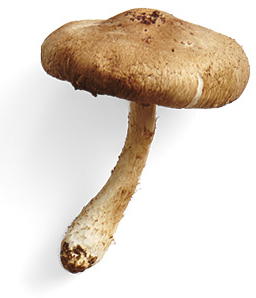
shiitake
The meaty texture and woodsy flavor of these mushrooms is delicious in soups, stir-fries, and noodle dishes. The stems are too tough to eat, so always remove them.
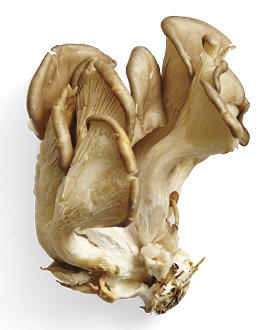
oyster
Tender and delicate oyster mushrooms are best served in lightly seasoned dishes (like this brothy noodle bowl) where their flavor can shine through.
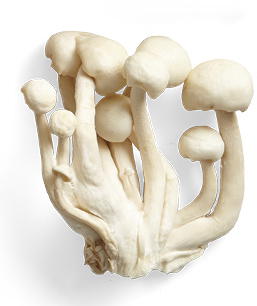
enoki
They may look like they’d be more at home in the ocean, but creamy-white enoki are definitely land dwellers. Their appearance makes them a unique addition to Asian-style dishes.
mix & match ingredients
NOODLES (Pick 1)
■ Angel hair pasta
■ Cellophane noodles
■ Ramen noodles
■ Rice noodles
■ Soba noodles
■ Udon noodles
PROTEIN (Pick 1)
■ One 12- to 14-oz. container firm tofu, cut into strips and chopped
■ 1 lb. beef sirloin, cut into bite-size strips
■ 1 lb. chicken breast, cut into bite-size strips
■ 1 lb. pork tenderloin, cut into bite-size strips
■ 1 lb. peeled and deveined shrimp
VEGETABLES (Pick 1–3)
■ Asparagus, trimmed and cut into 1-inch pieces
■ Baby bok choy, chopped
■ Broccoli florets
■ Carrots, thinly sliced
■ Shiitake or oyster mushrooms, stemmed and sliced
■ Snow pea pods, trimmed and bias- sliced
FLAVORING (Pick 1)
■ ¼ cup ketchup + 1 Tbsp. honey + 2–3 tsp. sambal oelek (chili paste)
■ 2 Tbsp. miso paste + ½ cup water
■ 2 Tbsp. red curry paste + 1 Tbsp. fish sauce + juice and zest of 1 lime
TOPPERS (Pick 1 or 2)
■ Finely chopped peanuts or cashews
■ Hard-boiled eggs, peeled and halved
■ Sliced green onions
■ Snipped fresh cilantro and/or Thai basil
■ Toasted sesame seeds

korean-style steak and noodles
Get the kimchi
This Korean condiment is a pungent, flavorful mixture of fermented Asian cabbage, carrots, and/or other vegetables. Because it’s fermented, kimchi is packed with probiotics (good for gut health). We’ll show you how to make your own (Kimchi) or look for it in the refrigerated section of large supermarkets.
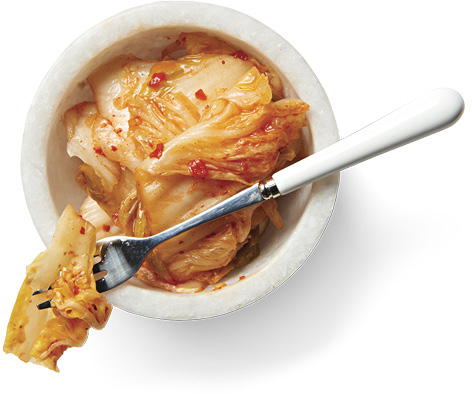
Korean-Style Steak and Noodles
hands-on time 20 minutes
marinate 30 minutes
- ¼ cup reduced-sodium soy sauce
- 2 Tbsp. rice vinegar
- 2 Tbsp. packed brown sugar
- 1 Tbsp. toasted sesame oil
- 1 Tbsp. gochujang paste (tip) or 1 tsp. sriracha sauce
- 1 lb. flank steak or skirt steak
- 8 oz. rice noodles or soba noodles
- 2 Tbsp. vegetable oil
- 8 oz. fresh shiitake mushrooms, stemmed and sliced
- 1 cup packaged julienned carrots
- 6 green onions, cut into 1-inch pieces (white and green parts)
- 2 cups fresh baby spinach
- 1 cup kimchi (tip, opposite), coarsely chopped
1. In a medium bowl combine the first five ingredients (through gochujang). Transfer 3 Tbsp. of the sauce mixture to a small bowl; cover and reserve for later. Slice steak against the grain into very thin slices.* Add steak to the remaining sauce in the medium bowl; stir to combine. Cover and refrigerate 30 minutes.
2. Meanwhile, soak or cook noodles according to package directions. Drain well.
3. Heat a large wok or 12-inch skillet over high heat. Add 1 Tbsp. of the vegetable oil. Drain meat; discard marinade. Add the meat to the hot oil. Cook and stir 1 to 2 minutes or until meat is just cooked through. Remove meat from wok.
4. Add remaining 1 Tbsp. vegetable oil to the wok. Place over high heat. Add mushrooms, carrots, and green onions. Cook and stir 3 to 4 minutes or just until crisp-tender. Add the noodles, reserved steak, spinach, and kimchi. Cook and stir 1 minute more or until spinach is wilted and mixture is heated through. Stir in the remaining soy sauce mixture; heat through. If desired, serve with additional kimchi.
Makes 4 servings (1½ cups each).
*note For easier slicing, wrap and freeze steak for 30 to 45 minutes before cutting it.
each serving 522 cal., 16 g fat (4 g sat. fat), 78 mg chol., 737 mg sodium, 62 g carb., 4 g fiber, 8 g sugars, 31 g pro.
Tofu-Cellophane Noodle Stir-Fry
start to finish 35 minutes
- 1 12- to 14-oz. pkg. extra-firm tofu
- 4 oz. cellophane noodles (bean threads) (noodle ID, Asian Noodles)
- 2 Tbsp. reduced-sodium soy sauce
- 2 Tbsp. rice vinegar
- 1 to 2 tsp. Asian chili paste (sambal oelek) (tip)
- 1 tsp. toasted sesame oil
- 2 Tbsp. canola oil
- 4 oz. shiitake mushrooms, stemmed and sliced ½ inch thick (1½ cups)
- 2 cloves garlic, thinly sliced
- 5 oz. yu choy, cut into 2-inch pieces (3 cups)
- 3 green onions, cut into 1½-inch pieces (white and green parts)
- ¼ cup water
- 3 Tbsp. hoisin sauce
- 2 tsp. grated fresh ginger
- ¼ tsp. ground cinnamon
- Dash ground cloves
- Lime wedges
- ¼ cup dry-roasted peanuts, chopped
1. Drain tofu. Pat dry with paper towels and place on a paper towel-lined plate. Cut into ¾-inch pieces.
2. Fill a 4-qt. saucepan with water and bring to boiling. Add cellophane noodles; remove from heat. Let stand 2 to 3 minutes or until noodles are softened. Drain; rinse with cool water and return to saucepan. Stir in soy sauce, vinegar, chili paste, and sesame oil.
3. In a 10-inch nonstick skillet heat 1 Tbsp. of the canola oil over medium heat. Add tofu; cook 5 to 7 minutes until lightly browned, tossing occasionally. Transfer to saucepan with noodles; gently toss.
4. Add remaining 1 Tbsp. canola oil to skillet. Add mushrooms; cook and stir 3 minutes. Add garlic; cook and stir 1 minute. Add yu choy and green onions; cook and stir 2 minutes or just until wilted. Add the next five ingredients (through cloves); cook and stir 1 minute. Add noodle mixture and cook until heated through, stirring occasionally.
5. Serve with lime wedges and peanuts.
Makes 4 servings (1 cup each).
each serving 361 cal., 18 g fat (2 g sat. fat), 0 mg chol., 548 mg sodium, 40 g carb., 4 g fiber, 7 g sugars, 13 g pro.

tofu-cellophane noodle stir-fry
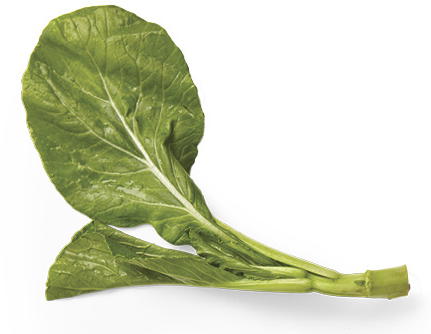
yu choy
This sweet-tasting leafy Asian vegetable is sometimes called choy sum and can be found in Asian markets. You can easily swap for an equal amount of baby bok choy or broccoli florets.